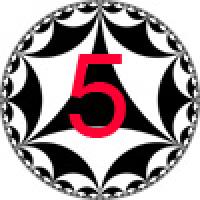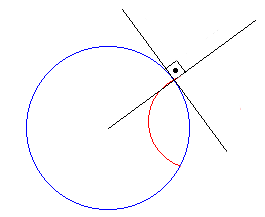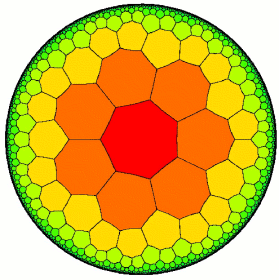
Plus Advent Calendar Door #5: Not always 180
Over 2000 years ago the Greek mathematician Euclid came up with a list of five postulates on which he thought geometry should be built. One of them, the fifth, was equivalent to a statement we are all familiar with: that the angles in a triangle add up to 180 degrees. However, this postulate did not seem as obvious as the other four on Euclid's list, so mathematicians attempted to deduce it from them: to show that a geometry obeying the first four postulates would necessarily obey the fifth. Their struggle continued for centuries, but in the end they failed. They found examples of geometries that do not obey the fifth postulate.
Spherical geometry

Image: Lars H. Rohwedder.
In spherical geometry the Euclidean idea of a line becomes a great circle, that is, a circle of maximum radius spanning right around the fattest part of the sphere. It is no longer true that the sum of the angles of a triangle is always 180 degrees. Very small triangles will have angles summing to only a little more than 180 degrees (because, from the perspective of a very small triangle, the surface of a sphere is nearly flat). Bigger triangles will have angles summing to very much more than 180 degrees.
One funny thing about the length of time it took to discover spherical geometry is that it is the geometry that holds on the surface of the Earth! But we never really notice, because we are so small compared to the size of the Earth that if we draw a triangle on the ground, and measure its angles, the amount by which the sum of the angles exceeds 180 degrees is so tiny that we can't detect it.
But there is another geometry that takes things in the other direction:
Hyperbolic geometry

Hyperbolic geometry isn't as easy to visualise as spherical geometry because it can't be modelled in three-dimensional Euclidean space without distortion. One way of visualising it is called the Poincaré disc.
Take a round disc, like the one bounded by the blue circle in the figure on the right, and imagine an ant living within it. In Euclidean geometry the shortest path between two points inside that disc is along a straight line. In hyperbolic geometry distances are measured differently so the shortest path is no longer along a Euclidean straight line but along the arc of a circle that meets the boundary of the disc at right angles, like the one shown in red in the figure. A hyperbolic ant would experience the straight-line path as a detour — it prefers to move along the arc of such a circle.
A hyperbolic triangle, whose sides are arcs of these semicircles, has angles that add up to less than 180 degrees. All the black and white shapes in the figure on the left are hyperbolic triangles.

One consequence of this new hyperbolic metric is that the boundary circle of the disc is infinitely far away from the point of view of the hyperbolic ant. This is because the metric distorts distances with respect to the ordinary Euclidean one. Paths that look the same length in the Euclidean metric are longer in the hyperbolic metric the closer they are to the boundary circle. The figure below shows a tiling of the hyperbolic plane by regular heptagons. Because of the distorted metric the heptagons are all of the same size in the hyperbolic metric. And as we can see the ant would need to traverse infinitely many of them to get to the boundary circle — it is infinitely far away!

Image created by David Wright.
Hyperbolic geometry may look like a fanciful mathematical construct but it has real-life uses. When Einstein developed his special theory of relativity in 1905 he found that the symmetries of hyperbolic geometry were exactly what he needed to formulate the theory. Today mathematicians believe that hyperbolic geometry may help to understand large networks like Facebook or the Internet.
You can read more about hyperbolic geometry in non-Euclidean geometry and Indra's pearls.
Return to the Plus advent calendar 2016.
This article comes from our Maths in a minute library.